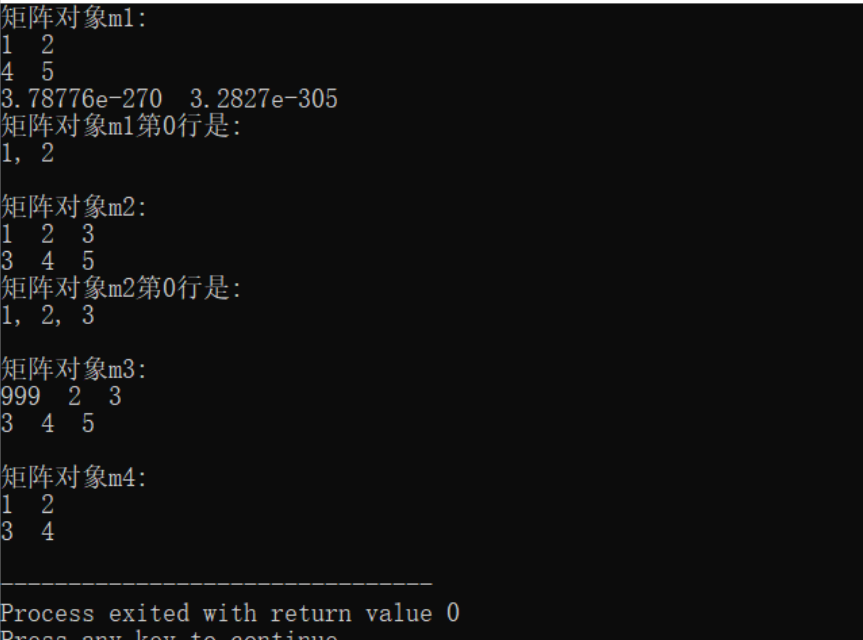任务1
task1.cpp

1 #include <iostream> 2 #include "point.hpp" 3 #include <vector> 4 using std::vector; 5 using std::cin; 6 void output(const vector<Point> &v) { 7 for(auto &t: v) 8 t.show(); 9 } 10 void test() { 11 int n; 12 cin >> n; 13 vector<Point> x(n); 14 cout << "x" << endl; 15 output(x); 16 vector<Point> y(x); 17 cout << "\nx " << endl; 18 output(y); 19 cout << "\nupdate x" << endl; 20 x.at(0).move(30, 50); 21 x.push_back(Point(2, 2)); 22 cout << "\nx total:" << endl; 23 output(x); 24 cout << "\ny total: " << endl; 25 output(y); 26 } 27 int main() { 28 test(); 29 }
point.hpp

1 #pragma once 2 #include <iostream> 3 using std::cout; 4 using std::endl; 5 class Point { 6 public: 7 Point(int x0 = 0, int y0 = 0); 8 ~Point() = default; 9 int get_x() const; 10 int get_y() const; 11 void show() const; 12 void move(int new_x, int new_y); 13 private: 14 int x, y; 15 }; 16 Point::Point(int x0, int y0): x{x0}, y{y0} { 17 } 18 int Point::get_x() const { 19 return x; 20 } 21 int Point::get_y() const { 22 return y; 23 } 24 void Point::show() const { 25 cout << "(" << x << ", " << y << ")" << endl; 26 } 27 void Point::move(int new_x, int new_y) { 28 x = new_x; 29 y = new_y; 30 }
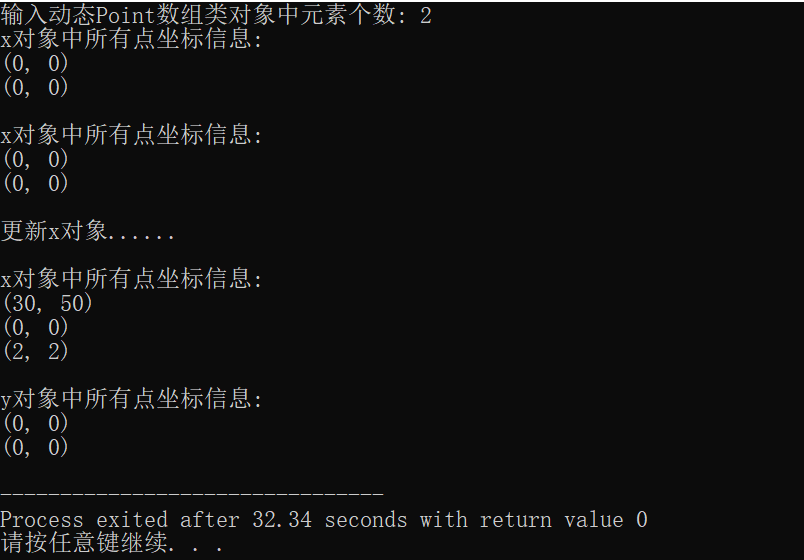
1:不发生变化
2:深复制
任务2
point.hpp

#pragma once #include <iostream> using std::cout; using std::endl; class Point { public: Point(int x0 = 0, int y0 = 0); ~Point() = default; int get_x() const; int get_y() const; void show() const; void move(int new_x, int new_y); private: int x, y; }; Point::Point(int x0, int y0): x{x0}, y{y0} { } int Point::get_x() const { return x; } int Point::get_y() const { return y; } void Point::show() const { cout << "(" << x << ", " << y << ")" << endl; } void Point::move(int new_x, int new_y) { x = new_x; y = new_y; }
vectorpoint.hpp

#pragma once #include "point.hpp" #include <cassert> #include <iostream> class vectorPoint{ public: vectorPoint(int n); ~vectorPoint(); int get_size() const; // 获得当前动态数组内元素个数 Point& at(int index); // 返回下标为index的元素引用 Point& at(int index) const; // 返回下标为index的元素const引用 private: int size; // 动态数组的大小 Point *ptr; }; vectorPoint::vectorPoint(int n) : size{n} { ptr = new Point[n]; } vectorPoint::~vectorPoint() { delete[] ptr; } int vectorPoint::get_size() const { return size; } Point& vectorPoint::at(int index) { assert(index >= 0 && index < size); // 宏,在测试模式下工作。如果不满足条件,则程序终止 return ptr[index]; } Point& vectorPoint::at(int index) const { assert(index >= 0 && index < size); return ptr[index]; }
task2.cpp

#include "vectorPoint.hpp" #include <iostream> // 输出vectorPoint对象内的所有数据 void output(const vectorPoint &v) { for(auto i = 0; i < v.get_size(); ++i) v.at(i).show(); } // 测试vectorPoint类:构造对象、复制构造对象 void test() { using namespace std; int n; cout << "输入vectorPoint对象中元素个数: "; cin >> n; vectorPoint x(n); cout << "x对象中所有点坐标信息: " << endl; output(x); vectorPoint y(x); cout << "\ny对象中所有点坐标信息: " << endl; output(y); cout << "\n更新x对象中点坐标信息......" << endl; x.at(0).move(30, 50); x.at(1).move(-1, -1); cout << "x对象中所有点坐标信息: " << endl; output(x); cout << "\ny对象中所有点坐标信息: " << endl; output(y); } int main() { test(); }
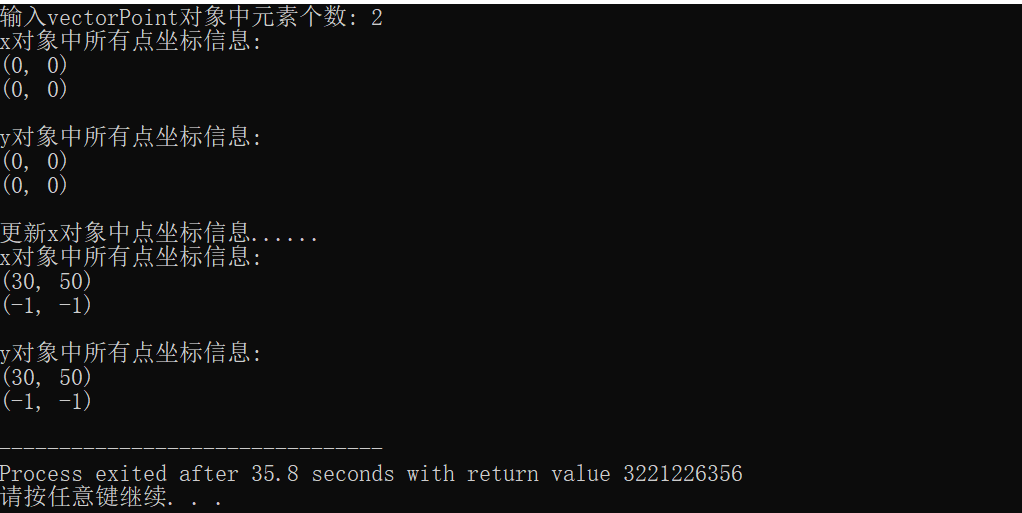
1:发生变化
2:浅复制
3:浅复制
任务3:
point.hpp

#pragma once #include <iostream> using std::cout; using std::endl; class Point { public: Point(int x0 = 0, int y0 = 0); ~Point() = default; int get_x() const; int get_y() const; void show() const; void move(int new_x, int new_y); private: int x, y; }; Point::Point(int x0, int y0): x{x0}, y{y0} { } int Point::get_x() const { return x; } int Point::get_y() const { return y; } void Point::show() const { cout << "(" << x << ", " << y << ")" << endl; } void Point::move(int new_x, int new_y) { x = new_x; y = new_y; }
vectorpoint.hpp

#pragma once #include "point.hpp" #include <cassert> #include <iostream> class vectorPoint{ public: vectorPoint(int n); vectorPoint(const vectorPoint &vp); ~vectorPoint(); int get_size() const; // 获得当前动态数组内元素个数 Point& at(int index); // 返回下标为index的元素引用 Point& at(int index) const; // 返回下标为index的元素const引用 private: int size; // 动态数组的大小 Point *ptr; }; vectorPoint::vectorPoint(int n) : size{n} { ptr = new Point[n]; } vectorPoint::vectorPoint(const vectorPoint &vp): size{vp.size}, ptr{new Point[size]} { for(auto i = 0; i < size; ++i) ptr[i] = vp.ptr[i]; } vectorPoint::~vectorPoint() { delete[] ptr; } int vectorPoint::get_size() const { return size; } Point& vectorPoint::at(int index) { assert(index >= 0 && index < size); // 宏,在测试模式下工作。如果不满足条件,则程序终止 return ptr[index]; } Point& vectorPoint::at(int index) const { assert(index >= 0 && index < size); return ptr[index]; }
task3.cpp

#include "vectorPoint.hpp" #include <iostream> // 输出vectorPoint对象内的所有数据 void output(const vectorPoint &v) { for(auto i = 0; i < v.get_size(); ++i) v.at(i).show(); } // 测试vectorPoint类:构造对象、复制构造对象 void test() { using namespace std; int n; cout << "输入vectorPoint对象中元素个数: "; cin >> n; vectorPoint x(n); cout << "x对象中所有点坐标信息: " << endl; output(x); vectorPoint y(x); cout << "\ny对象中所有点坐标信息: " << endl; output(y); cout << "\n更新x对象中点坐标信息......" << endl; x.at(0).move(30, 50); x.at(1).move(-1, -1); cout << "x对象中所有点坐标信息: " << endl; output(x); cout << "\ny对象中所有点坐标信息: " << endl; output(y); } int main() { test(); }
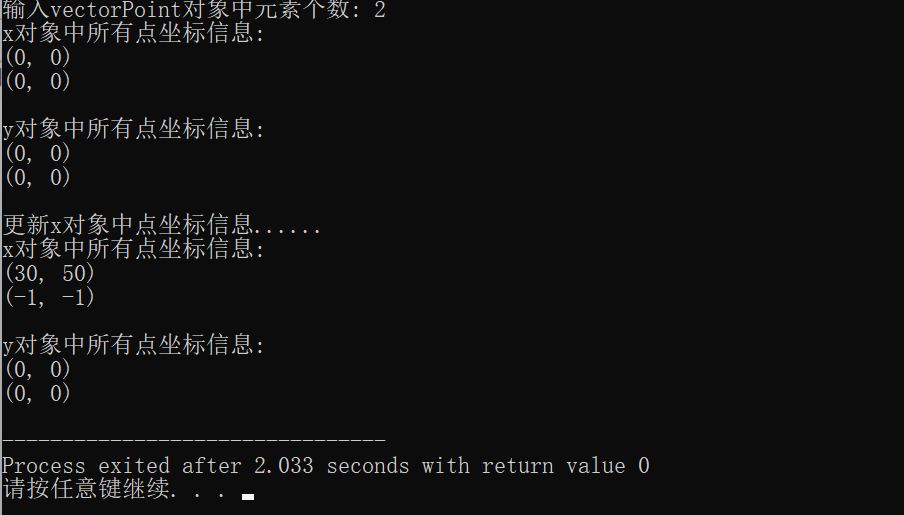
1:发生变化
2:浅复制
3:本次实验主要介绍了线性表的链式存储和操作的数据结构。通过使用链表来实现线性表,可以灵活地插入、删除元素,并且不需要预先分配内存空间。通过本次实验,我深刻理解了线性表的链式存储方式及其相关操作方法,并掌握了如何使用C语言来实现这些。
任务4
task4_1.cpp

#include <iostream> using namespace std; // 函数声明 void swap1(int &rx, int &ry); // 引用作为形参 void swap2(int *px, int *py); // 指针作为形参 void print(int x, int y); // 普通变量作为形参 // 测试代码 void test() { int x = 3, y = 4; print(x, y); swap1(x, y); // 函数调用,注意:引用作为形参时,实参形式 print(x, y); cout << endl; x = 3, y = 4; print(x, y); swap2(&x, &y); // 函数调用,注意:指针作为形参时,实参形式 print(x, y); } int main() { test(); } // 函数定义:交换两个变量(引用变量作为形参) void swap1(int &rx, int &ry) { int t; t = rx; rx = ry; ry = t; } // 函数定义:交换两个变量(指针变量作为形参) void swap2(int *px, int *py) { int t; t = *px; *px = *py; *py = t; } // 函数定义:输出两个变量(普通变量作为形参) void print(int x, int y) { std::cout << "x = " << x << ", y = " << y << "\n"; }

task4_2.cpp

#include <iostream> #include <typeinfo> using namespace std; int main() { int a; int &ra = a; ra = 4; int *pa = &a; *pa = 5; // 以十六进制形式输出普通变量a, 引用变量ra,指针变量pa的地址 cout << "&a = " << hex << &a << endl; cout << "&ra = " << hex << &ra << endl; cout << "&pa = " << hex << &pa << "\n\n"; // 输出普通变量a, 引用变量ra,指针变量pa的值 cout << "a = " << a << endl; cout << "ra = " << a << endl; cout << "pa = " << hex << pa << endl; // 输出指针变量pa指向的变量的值 cout << "*pa = " << *pa << "\n\n"; // 输出普通变量a,引用变量ra, 指针变量pa的类型信息 cout << "type a: " << typeid(a).name() << endl; cout << "type ra: " << typeid(ra).name() << endl; cout << "type pa: " << typeid(pa).name() << endl; }
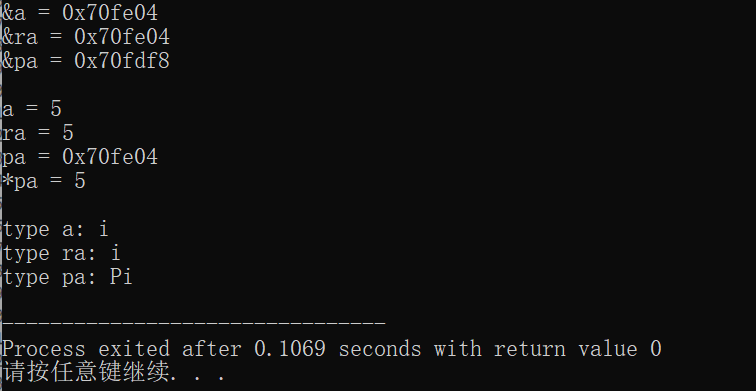
task4_3.cpp

#include <iostream> #include <vector> using namespace std; template<typename T> void output(const T &x) { for(auto i: x) std::cout << i << ", "; std::cout << "\b\b \n"; } template<typename T> void square1(T &x) { for(auto i: x) // i是普通类型 i *= i; } template<typename T> void square2(T &x) { for(auto &i: x) // i是引用类型 i *= i; } void test1() { vector<int> x {1, 2, 3, 4, 5}; cout << "动态int型数组对象x内的元素值: "; output(x); cout << "调用函数square1()......" << endl; square1(x); cout << "动态int型数组对象x内的元素值: "; output(x); } void test2() { vector<int> x {1, 2, 3, 4, 5}; cout << "动态int型数组对象x内的元素值: "; output(x); cout << "调用函数square2()......" << endl; square2(x); cout << "动态int型数组对象x内的元素值: "; output(x); } int main() { cout << "测试1: " << endl; test1(); cout << "\n测试2: " << endl; test2(); }

引用类型是指通过引用来访问对象,不需要进行内存分配和拷贝操作,可以直接修改原始对象。而指针类型是保存变量的地址,需要进行内存分配和拷贝操作,并且可以改变所指向的对象。引用类型更安全、简洁、易于使用,而指针类型更灵活、可控性高。
任务5
vectorInt.hpp

#ifndef VECTORINT_HPP #define VECTORINT_HPP #include <iostream> class vectorInt { private: int* data; // 动态数组指针 int size; // 数组大小 public: // 构造函数,动态指定数组大小 vectorInt(int n) : size(n) { std::cout << "constructor vectorInt(int n) called." << std::endl; data = new int[size]; } // 构造函数,动态指定数组大小,并将每个元素初始化为特定值value vectorInt(int n, int value) : size(n) { std::cout << "constructor vectorInt(int n, int value) called." << std::endl; data = new int[size]; for (int i = 0; i < size; ++i) { data[i] = value; } } // 拷贝构造函数,实现深复制 vectorInt(const vectorInt& other) : size(other.size){ std::cout << "copy constructor called." << std::endl; if (other.data != nullptr){ data = new int[size]; for (int i = 0; i < size; ++i){ data[i] = other.data[i]; } } else{ data=nullptr; } } ~vectorlnt(){ delete[]data; cout<<"destructor called"<<std::end1; } // 获取数组中数据项个数 int get_size() const{ returnsize; } // 访问第i个数据项 int at(ing index)const{ if(index>=0&&index<size){ return data[index]; }else{ std::cout<<"Invalid index!"<<std::end1; return 0; } } }; endif
task5.cpp

#include "vectorInt.hpp" #include <iostream> using std::cout; using std::cin; using std::endl; void output(const vectorInt &vi) { for (int i = 0; i < vi.get_size(); ++i) { cout << vi.at(i) << " "; } cout << endl; } void test() { int n; cout << "输入vectorInt对象中元素个数: "; cin >> n; vectorInt x1(n); // 构造动态int数组对象x1,包含n个元素,不对元素初始化 for(auto i = 0; i < n; ++i) x1.at(i) = i*i; cout << "vectorInt对象x1: "; output(x1); vectorInt x2(n, 42); // 构造动态int数组对象x1,包含n个元素,每个元素初始值为42 cout << "vectorInt对象x2: "; output(x2); vectorInt x3(x2); // 使用x2构造x3 cout << "vectorInt对象x3: "; output(x3); cout << "更新vectorInt对象x2......\n"; x2.at(0) = 77; x2.at(1) = -999; cout << "vectorInt对象x2: "; output(x2); cout << "vectorInt对象x3: "; output(x3); } int main() { test(); }
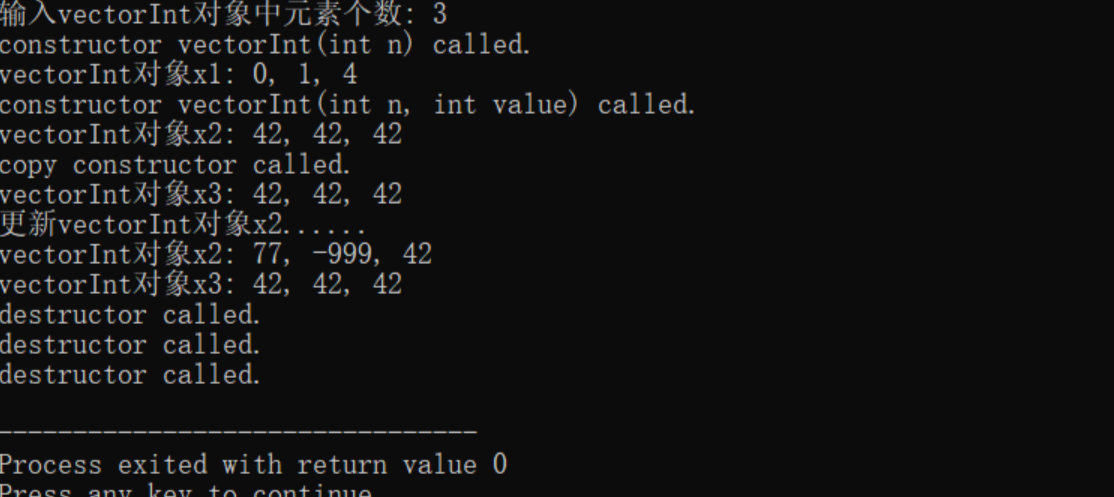
任务6
matrix.hpp

#pragma once #include <iostream> #include <cassert> using std::cout; using std::endl; class Matrix { public: Matrix(int n, int m); Matrix(int n); Matrix(const Matrix &x); ~Matrix(); void set(const double *pvalue); // 矩阵赋值 void setcint i, int j, double value); // 设置矩阵对象索引(i,j)的元素值为value double& atcint i, int j) const; // 返回矩阵对象索引(i,j)的元素引用 double& at(int i, int j); // 返回矩阵对象索引(i,j)的元素引用 int getlines() const; // 返回矩阵对象行数 int getcols() const; // 返回矩阵对象列数 void printO) const; |/按行打印输出矩阵对象元素值 private: int lines; int cols; double *ptr; }; #include "matrix.hpp" Matrix::Matrix(int n, int m): lines(n), cols(m), ptr(new double[n*m]) {} Matrix::Matrix(int n): lines(n), cols(n), ptr(new double[n*n]) {} Matrix::~Matrix() { delete[] ptr;} void Matrix::set(const double pvalue) { for (auto i = 0; i < linescols;++i) ptr[i] = pvalue[i]; } void Matrix::setcint i, int j,double value){ assert(i >= 0 && i < lines && j >= 0 && j < cols); ptr[i*cols+j] = value; } double& Matrix::atcint i, int j) const { assert(i >= 0 && i < lines && j >= 0 && j < cols); return ptr[i*cols+j]; } double& Matrix::at(int i, int j) { assert(i >= 0 && i < lines && j >= 0 && j < cols); return ptr[i*cols+j]; } int Matrix::get_lines() const { return lines; } int Matrix::get_cols() const { return cols; } void Matrix::printO) const { for(auto i = 0;i<lines;++i){ for(auto j=0;j<cols;++j) cout << at(i,j)<<","; cout << "\b\b \n"; } }
task6.cpp

#include <iostream> #include "matrix.hpp" using namespace std; const int N1 = 3; const int N2 = 2; // 输出一个矩阵对象中索引为index对应的行的所有元素值 void output(const Matrix &m, int index) { for(auto j = 0; j < m.get_cols(); ++j) cout << m.at(index, j) << ", "; cout << "\b\b \n"; } void test() { double x[N1*N2] = {1, 2, 3, 4, 5, 6}; Matrix m1(N1, N2); // 创建一个N1×N2矩阵 m1.set(x); // 用一维数组x的值按行为矩阵m1赋值 cout << "矩阵对象m1: " << endl; m1.print(); // 打印矩阵m1的值 cout << "矩阵对象m1第0行是: " << endl; output(m1, 0); cout << endl; Matrix m2(N2, N1); m2.set(x); cout << "矩阵对象m2: " << endl; m2.print(); cout << "矩阵对象m2第0行是: " << endl; output(m2, 0); cout << endl; Matrix m3(m2); // 用矩阵m2构造新的矩阵m3 m3.set(0, 0, 999); // 讲矩阵对象m2索引(0,0)元素设为999 cout << "矩阵对象m3:" << endl; m3.print(); cout << endl; Matrix m4(2); // 创建一个2*2矩阵对象 m4.set(x); // 用一维数组x的值按行为矩阵m4赋值 cout << "矩阵对象m4:" << endl; m4.print(); } int main() { test(); }
